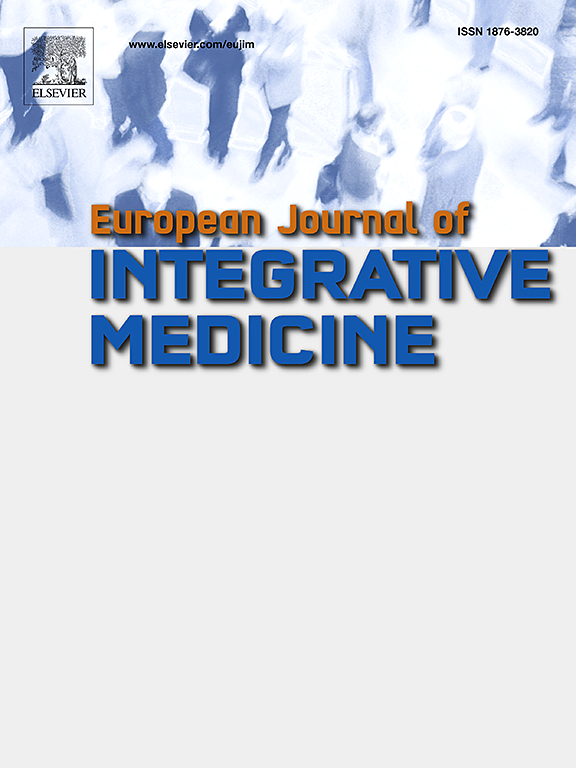An ethnobotanical study of plants and traditional herbal therapies in the Kara-Koy Gorge, Kyrgyz Republic
IF 1.7
4区 医学
Q3 INTEGRATIVE & COMPLEMENTARY MEDICINE
引用次数: 0
Abstract
Introduction
The Kara-Koy Gorge, located in the southern region of the Kyrgyz Republic, is home to a diverse array of plant species, many of which are known for their medicinal properties. Despite their historical use, the pharmacological properties of these plants remain largely unexplored. These species represent a potential source for the development of novel therapeutic agents. This study aimed to document traditional plant-based remedies, focusing on their preparation methods, therapeutic applications, and associated ailments, as reported by local custodians of traditional wisdom.
Methods
Ethnomedicinal data were collected between March 2021 and October 2022 through semi-structured interviews with local informants. Two ethnobotanical indices were applied to analyze the data. Plant specimens were collected, taxonomically identified, and preserved as voucher specimens.
Results
A total of 160 plant species, representing 123 genera and 47 botanical families were cited in homemade single-species herbal remedies. These remedies were employed for the treatment of 117 ailments, grouped into 14 therapeutic categories. The highest informant consensus factor values were recorded for digestive (0.86) and integumentary (0.84) disorders. Dracocephalum imberbe Bunge, D. ferganicum Lazkov, Plantago major L., and Rosa canina L. exhibited the highest use values of 0.98. Aerial parts were the most frequently used plant parts (37 %), and decoction was the predominant method of preparation (40 %).
Conclusion
The findings highlight the presence of underexplored plant species with significant ethnomedicinal potential. Future research should prioritize phytochemical profiling and pharmacological validation to substantiate and preserve this traditional local knowledge.
吉尔吉斯共和国Kara-Koy峡谷植物和传统草药疗法的民族植物学研究
卡拉-科伊峡谷位于吉尔吉斯共和国南部地区,是各种植物物种的家园,其中许多以其药用价值而闻名。尽管它们的历史用途,这些植物的药理学性质仍然很大程度上未被探索。这些物种代表了开发新型治疗剂的潜在来源。本研究旨在记录传统植物疗法,重点关注其制备方法、治疗应用和相关疾病,这些都是当地传统智慧守护者所报告的。方法在2021年3月至2022年10月期间,通过对当地信息提供者的半结构化访谈收集药物数据。采用两种民族植物学指标对数据进行分析。采集植物标本,进行分类鉴定,并作为代金券标本保存。结果国产单种中药共收录植物160种,隶属47科123属。这些疗法用于治疗117种疾病,分为14种治疗类别。在消化系统疾病(0.86)和肠道疾病(0.84)中,被调查者的共识因子值最高。利用价值最高的有龙头草(dracocphalum imberbe Bunge)、铁蹄草(D. ferganicum Lazkov)、车前草(Plantago major L.)和犬月季(Rosa canina L.),均为0.98。空中部位是最常用的植物部位(37%),汤剂是主要的制备方法(40%)。结论研究结果表明,该地区存在未被充分开发的具有重要民族医药潜力的植物物种。未来的研究应优先考虑植物化学分析和药理学验证,以证实和保护这一传统的地方知识。
本文章由计算机程序翻译,如有差异,请以英文原文为准。
求助全文
约1分钟内获得全文
求助全文
来源期刊

European Journal of Integrative Medicine
INTEGRATIVE & COMPLEMENTARY MEDICINE-
CiteScore
4.70
自引率
4.00%
发文量
102
审稿时长
33 days
期刊介绍:
The European Journal of Integrative Medicine (EuJIM) considers manuscripts from a wide range of complementary and integrative health care disciplines, with a particular focus on whole systems approaches, public health, self management and traditional medical systems. The journal strives to connect conventional medicine and evidence based complementary medicine. We encourage submissions reporting research with relevance for integrative clinical practice and interprofessional education.
EuJIM aims to be of interest to both conventional and integrative audiences, including healthcare practitioners, researchers, health care organisations, educationalists, and all those who seek objective and critical information on integrative medicine. To achieve this aim EuJIM provides an innovative international and interdisciplinary platform linking researchers and clinicians.
The journal focuses primarily on original research articles including systematic reviews, randomized controlled trials, other clinical studies, qualitative, observational and epidemiological studies. In addition we welcome short reviews, opinion articles and contributions relating to health services and policy, health economics and psychology.
 求助内容:
求助内容: 应助结果提醒方式:
应助结果提醒方式:


